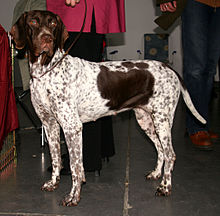
The Vizsla is a dog breed from Hungary and belongs to the Federation Cynologique Internationale (FCI) group 7, the Canadian Kennel Club (CKC) group 1, and the American Kennel Club. Its name means "searcher" or "tracker" in Hungarian. The Hungarian or Magyar Vizsla or Smooth-Haired Vizsla are sporting dogs and loyal companions. The Vizsla's medium size is one of the breed's most appealing characteristics. As a hunter of fowl and upland game, the Vizsla has held a prominent position among sporting dogs – that of household companion and family dog.

The Alaskan Malamute is a large breed of dog that was originally bred for their strength and endurance to haul heavy freight as a sled dog and hound. They are similar to other arctic, husky, and spitz breeds such as the Greenland Dog, Canadian Eskimo Dog, the Siberian Husky, and the Samoyed.
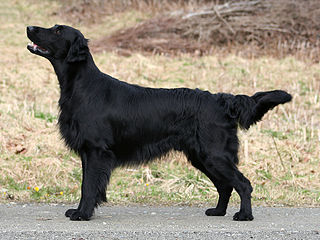
The Flat-coated Retriever is a gundog breed originating from England. It was developed as a retriever both on land and in the water.

A retriever is a type of gun dog that retrieves game for a hunter. Generally gun dogs are divided into three major classifications: retrievers, flushing spaniels, and pointing breeds. Retrievers were bred primarily to retrieve birds or other prey and return them to the hunter without damage; retrievers are distinguished in that nonslip retrieval is their primary function. As a result, retriever breeds are bred for soft mouths and a great willingness to please, learn, and obey. A soft mouth refers to the willingness of the dog to carry game in its mouth without biting into it. "Hard mouth" is a serious fault in a hunting dog and is very difficult to correct. A hard-mouthed dog renders game unpresentable or at worst inedible.

The Smooth Collie is a breed of dog developed originally for herding. It is a short-coated version of the Rough Collie of Lassie fame. Some breed organisations consider the smooth-coat and rough-coat dogs to be variations of the same breed.

The Finnish Spitz is a breed of dog originating in Finland. The breed was originally bred to hunt all types of game from squirrels and other rodents to bears. It is a "bark pointer", indicating the position of game by barking, and drawing the game animal's attention to itself, allowing an easier approach for the hunter. Its original game hunting purpose was to point to game that fled into trees, such as grouse, and capercaillies, but it also serves well for hunting elk. Some individuals have even been known to go after a bear. In its native country, the breed is still mostly used as a hunting dog. The breed is friendly and in general loves children, so it is suitable for domestic life. The Finnish Spitz has been the national dog of Finland since 1979.

The Irish Setter is a setter, a breed of gundog, and family dog. The term Irish Setter is commonly used to encompass the show-bred dog recognised by the American Kennel Club as well as the field-bred Red Setter recognised by the Field Dog Stud Book.

The Catalan sheepdog is a breed of Catalan Pyrenean dog used as a sheepdog. This dog is bred in Europe, especially in Spain, Finland, Germany, and Sweden.

The Drentsche Patrijshond is a versatile spaniel-type hunting dog from the Dutch province of Drenthe. Called the Dutch Partridge Dog in English, approximately 5,000 dogs are registered with the breed club in the Netherlands, and breed clubs operate in Belgium, Denmark, Scandinavia and North America. The Drentsche Patrijshond bears some resemblance to both spaniel and setter types of dog. An excellent pointer and retriever, this dog is often used to hunt fowl and adapts equally well to the field or marshes.

The Small Münsterländer is a versatile hunting-pointing-retrieving dog breed that reached its current form in the area around Münster, Germany. The Large Münsterländer is from the same area, but was developed from different breeding stock and is not related as the names would suggest. Small Münsterländers bear a resemblance to both spaniels and setters but are more versatile while hunting on land and water. The Small Münsterländer is recognized by the Fédération Cynologique Internationale under Group 7, Section 1.2, Continental Pointing Dogs of Spaniel type, by the American Kennel Club as a Foundation Stock Service breed, and by The Kennel Club and the United Kennel Club as a gun dog. It is related to the Epagneul Français and the Drentsche Patrijshond.

The Stabyhoun or Stabij is one of the top five rarest dog breeds in the world. It is from the Dutch province of Friesland and in particular from the Frisian forest area, a region in the southeast and east of Friesland. The breed has been mentioned in Dutch literature going back to the early 1800s, but has only extended its range from the 1960s outside of Friesland and not until the 2000s did the range officially extend beyond the Netherlands. The name Stabij translates roughly as "stand by me" with the last part simply Frisian, meaning dog, which is pronounced "hoon". The dog is considered a Dutch national treasure. There are only a few thousand Stabyhouns in existence today worldwide.
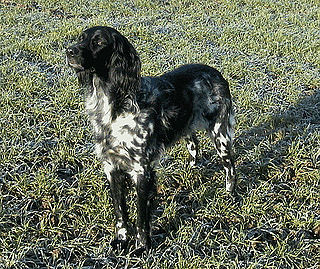
The Large Münsterländer is a breed of gun dog originally from the Münster region in Germany.

The Eurasier, or Eurasian dog, is a breed of dog of the spitz type that originated in Germany. It is widely known as a wonderful companion that maintains its own personality, has a dignified reserve to strangers, a strong bond to its family and that is relatively easy to train.

The German Longhaired Pointer (GLP) is a breed of dog. Developed in Germany, it is used as a multipurpose gundog. It is closely related to its cousins, the German Shorthaired Pointer (GSP), the German Wirehaired Pointer (GWP) and the Large Münsterländer, which was previously part of the breed.

A Portuguese Pointer, is a breed of dog developed as a gun dog. It is one of several pointing breeds and is mainly used in red-legged partridge hunting.

The Český Fousek is a Czech breed of versatile hunting dog that was traditionally and currently used to hunt, point, and retrieve. This refers to the dog's natural ability in tracking, pointing, and retrieving game. The name is in Czech, in which český means Czech and fousek is derived from vousy or vousky ( whiskers). While the name is used for both sexes, Český Fousek specifically refers to a male dog while the female is traditionally called Česka Fouska. The breed is part of the griffon hunting dog family and have the beard and moustache common to wirehairs. There is a large difference in size between the females and males of this breed, with the weight difference being up to 11 kilograms (24 lb).
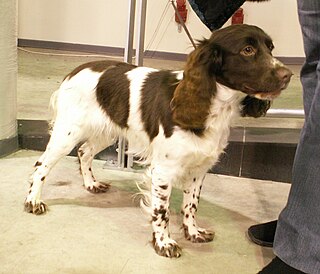
The Russian Spaniel is a type of spaniel first standardised in 1951 in the Soviet Union after World War II by cross breeding English Cocker Spaniels, English Springer Spaniels and other spaniel breeds. In 1951, the standard of the Russian spaniel was adopted, the selection of dogs for breeding began to be carried out in accordance with the requirements. Physically it is similar to a Cocker Spaniel, but has a shorter, tighter coat and a longer body. Developed and used as hunting dogs, this breed does not suffer from any major health complaints other than those normally associated with spaniels. It is the only gun dog breed originated in Russia. It is used for hunting game birds and hares. Popular in its native Russia, the breed was only introduced overseas in the 1990s, and is not yet recognised by any major kennel clubs, but is recognised by Russian Kynological Federation.

The Wirehaired Vizsla, is a dog breed originating in Hungary. Wirehaired Vizslas are known as excellent hunting dogs, and also have a level personality making them suited for families. The Wirehaired Vizsla is a versatile, natural hunter endowed with an excellent nose and an above average trainability. Although they are lively, gentle mannered, demonstrably affectionate and sensitive, they are also fearless and possessed of a well-developed protective instinct. The breed has a firmness on point, is an excellent retriever, and has the determination to remain on the scent even when swimming. The overall appearance embodies the qualities of a multi-purpose pointing dog, endurance, working ability and an easily satisfied nature. This is a dog of power and drive in the field, yet is a tractable and affectionate companion in the home.
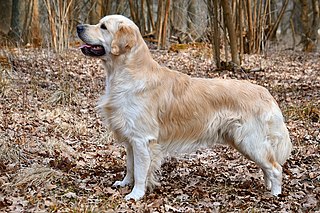
The Golden Retriever is a medium-large gun dog that was bred to retrieve shot waterfowl, such as ducks and upland game birds, during hunting and shooting parties. The name "retriever" refers to the breed's ability to retrieve shot game undamaged due to their soft mouth. Golden retrievers have an instinctive love of water, and are easy to train to basic or advanced obedience standards. They are a long-coated breed, with a dense inner coat that provides them with adequate warmth in the outdoors, and an outer coat that lies flat against their bodies and repels water. Golden retrievers are well suited to residency in suburban or country environments. They shed copiously, particularly at the change of seasons, and require fairly regular grooming. The Golden Retriever was originally bred in Scotland in the mid-19th century.

The Braque Saint-Germain is a medium-large breed of dog, a versatile hunter used for hunting as a gun dog and pointer as well as for hunting other small game. Braque is a term meaning pointing dogs. The breed was created around 1830 by crossing English and French pointing type dogs.
